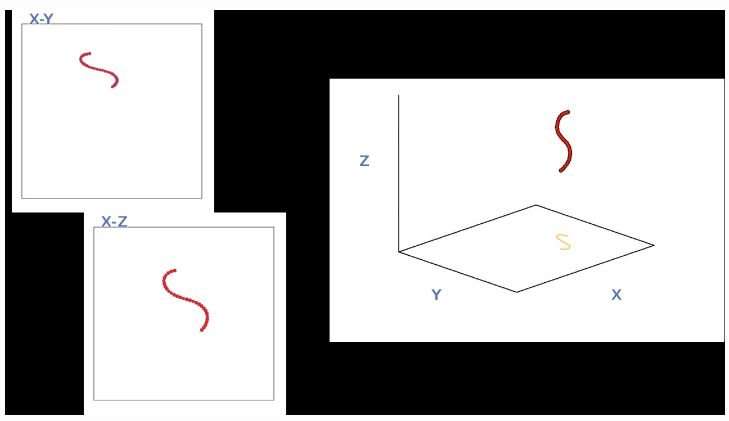Researchers unravel 3-D locomotion of the nematode C. elegans

Jerzy Blawzdziewicz, professor, associate chairman and director of graduate studies in the Department of Mechanical Engineering, and Siva Vanapalli, an associate professor and Bill Sanderson faculty fellow in the Department of Chemical Engineering in Texas Tech University's Edward E. Whitacre Jr. College of Engineering, had their research paper, "Roll Maneuvers are Essential for Active Reorientation of Caenorhabditis elegans in 3-D Media," recently published in the Proceedings of the National Academy of Sciences (PNAS).
C. elegans, a one-millimeter roundworm, is a powerful model organism used in investigations of fundamental biological processes conserved across species. Researchers around the world measure locomotory behavior of this nematode to gain insights into diverse areas of study such as genetic mutations, muscle biology, neural control of movement and evaluation of nutrition, exercise and drug effects.
Most research results using locomotory readouts have been based on two-dimensional (2-D) descriptions of the nematode movement. In laboratories, C. elegans is usually grown on an agar gel surface, and 2-D models provide a wealth of useful information. However, some of the worm's behaviors, such as burrowing and swimming, require a three-dimensional (3-D) investigative approach.
Moreover, in its natural habitat, which is moist, decomposing organic matter, the nematode moves in a complex 3-D environment. Yet, so far there have been no comprehensive quantitative studies of the worm's 3-D gait.
In their paper, Blawzdziewicz, Vanapalli and their team identified and quantified key maneuvers the nematode uses to explore 3-D space. Their collaborative research effort was based on the vital contributions from two mechanical engineering doctoral students, Alejandro Bilbao and Amar Patel, who obtained theoretical results, and from a chemical engineering postdoctoral researcher, Mizanur Rahman, who conducted the experiments.
"We are looking at the way this tiny animal moves in its environment and what kind of maneuvers it is executing," Blawzdziewicz said. "In 2-D, the nematode propels its body using sideways undulations and turns by momentarily increasing undulation amplitude on one side. We have found that, to reorient itself in 3-D, the nematode performs a roll maneuver, which resembles an airplane acrobatic roll. The animal efficiently rotates about the axis of its trajectory (executing the 3-D part of its movement), then resumes 2-D turns in a new undulation plane. We have recorded this new behavioral pattern and theoretically analyzed its efficiency, frequency and significance."
The genome of C. elegans was the first fully sequenced one, and the nematode's neural system is completely mapped. This aids in research studies because it is now the go-to animal model for various diseases.
The short gestation and aging period of C. elegans is another benefit to using the animal.
"It's a transparent worm, so you can see through it, which has its advantages, and each animal lays about 300 eggs," Vanapalli said. "Each animal lives for about three weeks, so in that short time, you can monitor a large number of nematodes. If you think about aging studies, which is one of the areas Jerzy and I are interested in, a major goal is to understand what genetic mutations and which drugs can improve neuromuscular health as the animal ages. A mouse lives for two years, so it's a very long time to track, a very long experiment. But here, it's three weeks.
"We intend to use our 3-D locomotion analysis to characterize the health of nervous and muscular systems in aging worms. The 3-D approach is a more sensitive tool compared to evaluating C. elegans locomotion in 2-D."
The investigations of the Texas Tech research group already pose a new, important and open question of how 3-D body postures involved in roll maneuvers are actuated by, essentially, a two-dimensional network of neural connections.
C. elegans has four rows of muscles along its body, so actuation in any direction should be possible. However, motor neurons in most of the body have symmetrical connections to either ventral or dorsal muscles, and because of these symmetric connections, it is generally thought that C. elegans is unable to actuate 3-D movements, except in the head segment of its body.
"Our analysis shows that the entire nematode body is capable of 3-D movements," Blawzdziewicz said. "The question thus arises how the motor neuron connected to two muscles can send different signals to elicit asymmetric response in these muscles."
The research was funded by the National Science Foundation, the National Institutes of Health and NASA.
One of the simulations demonstrating the geometry and mechanics of 2-D turns and 3-D roll maneuvers in swimming is shown below.
More information: Alejandro Bilbao et al. Roll maneuvers are essential for active reorientation of Caenorhabditis elegansin 3-D media, Proceedings of the National Academy of Sciences (2018). DOI: 10.1073/pnas.1706754115
Journal information: Proceedings of the National Academy of Sciences
Provided by Texas Tech University



















